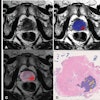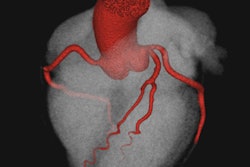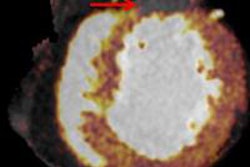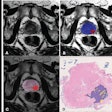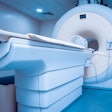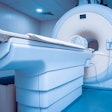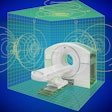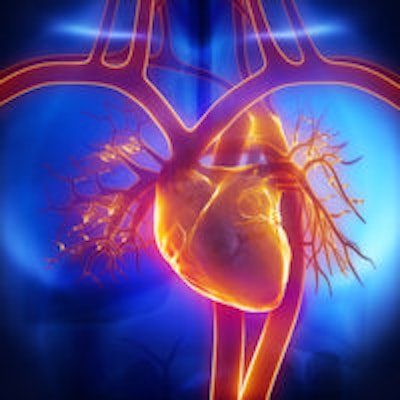
A trial comparing the use of coronary CT angiography (CCTA) to standard care alone in more than 4,000 chest pain patients revealed sharply reduced event rates and fewer negative angiographies when CCTA was used to guide patient management, according to results published in the Journal of the American College of Cardiology.
The multicenter Scottish Computed Tomography of the Heart (SCOT-HEART) trial evaluated the impact of CCTA on patients referred to a cardiology clinic. CCTA clarifies the diagnosis of patients with coronary disease, leading to more appropriate use of invasive angiography and care management changes that reduced myocardial infarctions dramatically, concluded lead author Dr. Michelle Williams, along with Dr. Amanda Hunter, Dr. Anoop Shah, and colleagues (JACC, April 19, 2016, Vol. 67:15, pp. 1759-1768).
"This was the first demonstration that CCTA can markedly influence clinical decision-making and improve patient outcomes," said corresponding author Dr. David Newby from the University of Edinburgh in an email to AuntMinnie.com.
A lack of evidence
Both U.S. and European guidelines suggest several noninvasive tests for patients with stable chest pain, but there is little "definitive or consistent evidence" to recommend one over another, the authors wrote. In fact, U.S. guidelines specifically favor stress testing, reserving CCTA for patients who cannot take a treadmill stress test.
Because it would be impractical and ethically dubious to perform invasive angiography in all patients with suspected coronary disease, the authors used angiography outcomes as a surrogate to assess CCTA's impact. If CT improved patient management, the number of negative invasive angiographies would also drop in patients whose care was directed by CCTA results, they hypothesized.
Previous studies assessed CCTA's diagnostic accuracy versus invasive angiography, but "the SCOT-HEART trial asked, what is the clinical benefit of CCTA [when used] in addition to the current standard of care?" wrote Newby, adding that "no trial had previously seen an impact on subsequent myocardial infarction."
Evaluating chest pain
The researchers analyzed the results of 4,146 patients (56% male; mean age, 57 years; range, 18-75 years; mean body mass index, 30 ± 6 kg/m2) who were randomized to either standard care (including a treadmill stress test) or standard care plus CCTA for stable chest pain with suspected coronary heart disease. The median follow-up time was 20 months.
Post hoc analyses assessed changes in the ordering of invasive coronary angiography, preventive care, and outcomes based on electronic health records.
Patients in the CT arm underwent coronary CCTA using 64-detector-row CT (Brilliance 64, Philips Healthcare, or Biograph mCT, Siemens Healthcare) or 320-detector-row CT (Aquilion One, Toshiba Medical Systems) at one of three imaging sites. Two experienced readers interpreted the results, defining them as normal or nonobstructive mild, moderate, or obstructive disease.
The investigators performed coronary angiography according to routine clinical practice, with results categorized as normal, nonobstructive, or obstructive.
Prescriptions data were kept and long-term outcomes data were obtained from the Scottish Morbidity Record and General Register Office. Data were analyzed using Cox proportional hazards regression.
Better care and outcomes with CCTA
Among the 4,146 patients, 2,073 were assigned to standard care and 2,073 to standard care plus CCTA. The patients were followed for a median of 20 months (range, 3-48 months).
The rates of invasive angiography were similar between the groups, with 409 angiography studies in the CCTA group versus 401 in the standard-care group (p = 0.451).
But there were fewer negative -- that is, normal -- invasive angiography exams in the patients who received CCTA, indicating that CCTA was effective in determining which patients should get the invasive procedure. Invasive angiography was less likely to reveal normal coronary arteries in the CCTA group than in the standard-care group (20 versus 56), with a hazard ratio (HR) of 0.39 (95% confidence interval: 0.23-0.68).
"The number of negative (normal) invasive angiographies was reduced by nearly two-thirds," Newby told AuntMinnie.com.
The study also demonstrated that CCTA affected how patients were managed. Far more preventive therapies were undertaken in the CT group (n = 283) than in the standard-care group (n = 74, HR = 4.03).
"Compared with standard care, there were marked differences in the recommendations of how the patients were to be managed and treated following CCTA," Williams and colleagues wrote.
In a first, the study accounted for the timing of these changes based on electronic records that showed the exact dates on which medications were dispensed to individual patients.
"This was a major strength of our study and has not previously been employed in other trials of this type," the authors wrote.
| Outcomes using standard care vs. CCTA | |||
| Standard care (n = 2,073) | CCTA (n = 2,073) | p-value | |
| Angiographies | 409 | 401 | 0.451 |
| Preventive therapies | 283 | 74 | < 0.001 |
| Revascularizations | 201 | 233 | 0.061 |
| Normal angiographies | 56 | 20 | < 0.001 |
| Myocardial infarction during follow-up | 34 | 17 | < 0.01 |
Management guided by CCTA yielded clear outcomes benefits. From the median 50 days after therapy initiation, the rate of fatal and nonfatal myocardial infarction was reduced in CCTA patients (n = 17) versus the standard-care group (n = 34, HR = 4.03, p < 0.01).
With CCTA, event rates "were halved when you account for the delays in implementation," Newby said. "I think this is excellent value for the money."
Cumulative six-month costs were a little higher with CCTA by a mean of $462, which the authors attributed to the cost of CCTA itself. There were no differences between the groups in costs for outpatient, day-case, or inpatient services, reflecting similar rates of investigations and procedures following randomization to CCTA or standard care.
"We conclude that the changes in diagnosis consequent on CCTA led to appropriate changes in the selection of patients for invasive coronary angiography and the more effective implementation of preventive therapies, which were associated with a halving in the subsequent rate of fatal and nonfatal [myocardial infarction]," they wrote.
This is the first trial to reveal clinical benefits "through better targeted investigations and treatments in patients presenting with suspected angina pectoris" due to coronary disease, according to the authors.
Editorial comment
In an accompanying editorial (pp. 1769-1771), Dr. James Min and colleagues from Weill Cornell Medical College in New York City said the authors should be commended for high-quality work that shows a better approach to preventive care when CCTA is used.
"Adoption of this forward-looking approach should not mitigate the importance of ischemia-causing CAD, given the wealth of observational data for stress testing," they wrote. "However, it is possible that the addition of information related to stenosis and atherosclerosis may complement or, on the basis of the current study results, be superior to stress testing for improving outcomes."
The recent introduction of noninvasive fractional flow reserve from CT images will also permit clinicians to integrate the findings of lesion-specific ischemia with cardiac function, finally attaining the goal of a "one-stop shop" for coronary evaluation, Min and colleagues wrote.
In a new study, the authors are evaluating patients at high risk for coronary disease who are presenting to the emergency department.



